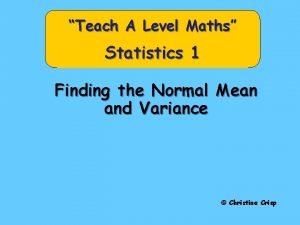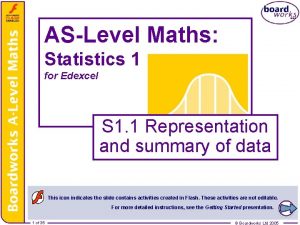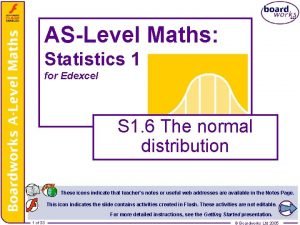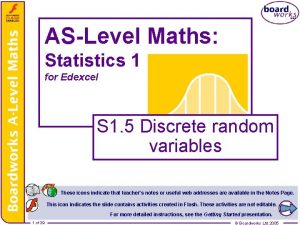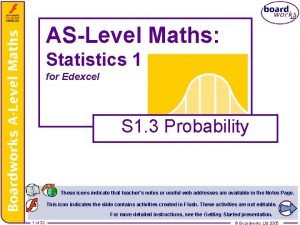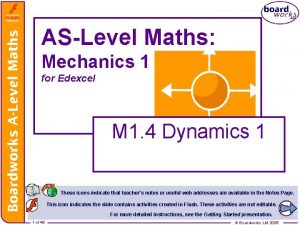ASLevel Maths Statistics 1 for Edexcel S 1


























- Slides: 26

AS-Level Maths: Statistics 1 for Edexcel S 1. 2 Calculating means and standard deviations These icons indicate that teacher’s notes or useful web addresses are available in the Notes Page. This icon indicates the slide contains activities created in Flash. These activities are not editable. For more detailed instructions, see the Getting Started presentation. 11 of of 26 26 © Boardworks Ltd 2005

Contents Means Calculating means Calculating standard deviations Coding 22 of of 26 26 © Boardworks Ltd 2005

Mean The mean is the most widely used average in statistics. It is found by adding up all the values in the data and dividing by how many values there are. Notation: If the data values are mean is This is the mean symbol , then the This symbol means the total of all the x values Note: The mean takes into account every piece of data, so it is affected by outliers in the data. The median is preferred over the mean if the data contains outliers or is skewed. 3 of 26 © Boardworks Ltd 2005

Mean If data are presented in a frequency table: Value Frequency … … then the mean is 4 of 26 © Boardworks Ltd 2005

Mean Example: The table shows the results of a survey into household size. Find the mean size. Household size, x Frequency, f x×f 1 20 20 2 28 56 3 25 75 4 19 76 5 16 80 6 6 36 TOTAL 114 343 To find the mean, we add a 3 rd column to the table. Mean = 343 ÷ 114 = 3. 01 5 of 26 © Boardworks Ltd 2005

Contents Standard deviation Calculating means Calculating standard deviations Coding. 66 of of 26 26 © Boardworks Ltd 2005

Standard deviation There are three commonly used measures of spread (or dispersion) – the range, the inter-quartile range and the standard deviation. The standard deviation is widely used in statistics to measure spread. It is based on all the values in the data, so it is sensitive to the presence of outliers in the data. The variance is related to the standard deviation: variance = (standard deviation)2 The following formulae can be used to find the variance and s. d. 7 of 26 © Boardworks Ltd 2005

Standard deviation Example: The mid-day temperatures (in ˚C) recorded for one week in June were: 21, 23, 24, 19, 20, 21 First we find the mean: ˚C 21 0 0 23 2 4 24 3 9 So variance = 22 ÷ 7 = 3. 143 19 -2 4 So, s. d. = 1. 77 ˚C (3 s. f. ) 20 -1 1 21 0 0 Total: 22 8 of 26 © Boardworks Ltd 2005

Standard deviation There is an alternative formula which is usually a more convenient way to find the variance: Therefore, 9 of 26 and © Boardworks Ltd 2005

Standard deviation Example (continued): Looking again at the temperature data for June: 21, 23, 24, 19, 20, 21 We know that ˚C Also, = 3109 So, ˚C Note: Essentially the standard deviation is a measure of how close the values are to the mean value. 10 of 26 © Boardworks Ltd 2005

Calculating standard deviation from a table When the data is presented in a frequency table, the formula for finding the standard deviation needs to be adjusted slightly: Example: A class of 20 students were asked how many times they exercise in a normal week. Find the mean and the standard deviation. 11 of 26 Number of times exercise taken Frequency 0 5 1 3 2 5 3 4 4 2 5 1 © Boardworks Ltd 2005

Calculating standard deviation from a table No. of times exercise taken, x Frequency, f x×f x 2 × f 0 5 0 0 1 3 3 3 2 5 10 20 3 4 12 36 4 2 8 32 5 1 5 25 20 38 TOTAL: 116 The table can be extended to help find the mean and the s. d. 12 of 26 © Boardworks Ltd 2005

Calculating standard deviation from a table If data is presented in a grouped frequency table, it is only possible to estimate the mean and the standard deviation. This is because the exact data values are not known. An estimate is obtained by using the mid-point of an interval to represent each of the values in that interval. Example: The table shows the annual mileage for the employees of an insurance company. Estimate the mean and standard deviation. 13 of 26 Annual mileage, x Frequency 0 ≤ x < 5000 7 5000 ≤ x < 10, 000 18 10, 000 ≤ x < 15, 000 14 15, 000 ≤ x < 20, 000 4 20, 000 ≤ x < 30, 000 2 © Boardworks Ltd 2005

Calculating standard deviation from a table Mileage Frequency, f Mid-point, x f×x f × x 2 0 – 5000 6 2500 15000 37, 500, 000 5000 – 10, 000 17 7500 127, 500 956, 250, 000 10, 000 – 15, 000 14 12, 500 175, 000 2, 187, 500, 000 15, 000 – 20, 000 5 17, 500 87, 500 1, 531, 250, 000 20, 000 – 30, 000 3 25, 000 75, 000 1, 875, 000 480, 000 6, 587, 500, 000 TOTAL 45 miles 14 of 26 © Boardworks Ltd 2005

Notes about standard deviation Here are some notes to consider about standard deviation. In most distributions, about 67% of the data will lie within 1 standard deviation of the mean, whilst nearly all the data values will lie within 2 standard deviations of the mean. Values that lie more than 2 standard deviations from the mean are sometimes classed as outliers – any such values should be treated carefully. Standard deviation is measured in the same units as the original data. Variance is measured in the same units squared. Most calculators have built-in functions which will find the standard deviation for you. Learn how to use this facility on your calculator. 15 of 26 © Boardworks Ltd 2005

Examination style question: The ages of the people in a cinema queue one Monday afternoon are shown in the stem-and-leaf diagram: a) Explain why the diagram suggests that the mean and standard deviation can be sensibly used as measures of location and spread respectively. b) Calculate the mean and the standard deviation of the ages. c) The mean and the standard deviation of the ages of the people in the queue on Monday evening were 29 and 6. 2 respectively. Compare the ages of the people queuing at the cinema in the afternoon with those in the evening. 16 of 26 © Boardworks Ltd 2005

Examination style question a) The mean and the standard deviation are appropriate, as the distribution of ages is roughly symmetrical and there are no outliers. b) c) The cinemagoers in the evening had a smaller mean age, meaning that they were, on average, younger than those in the afternoon. The standard deviation for the ages in the evening was also smaller, suggesting that the evening audience were closer together in age. 17 of 26 © Boardworks Ltd 2005

Combining sets of data Sometimes in examination questions you are asked to pool two sets of data together. Example: Six male and five female students sit an A level examination. The mean marks were 52% and 57% for the males and females respectively. The standard deviations were 14 and 18 respectively. Find the combined mean and the standard deviation for the marks of all 11 students. 18 of 26 © Boardworks Ltd 2005

Combining sets of data Let be the marks for the 6 male students. Let be the marks of the 5 female students. To find the overall mean, we first need to find the total marks for all 11 students. Therefore So the combined mean is: 19 of 26 © Boardworks Ltd 2005

Combining sets of data To find the overall standard deviation, we need to find the total of the marks squared for all 11 students. Notice that the formula rearranges to give Therefore, So the combined s. d. is: 20 of 26 to 3 s. f. © Boardworks Ltd 2005

Contents Coding Calculating means Calculating standard deviations Coding. 21 21 of of 26 26 © Boardworks Ltd 2005

Coding is a technique that can simplify the numerical effort required in finding a mean or standard deviation. Enter some data below, and see how it changes when you add or multiple by different numbers. 22 of 26 © Boardworks Ltd 2005

Coding Adding So, if a number b is added to each piece of data, the mean value is also increased by b. The standard deviation is unchanged. Multiplying If each piece of data is multiplied by a, the mean value is multiplied by a. The standard deviation is also multiplied by a. More formally, if 23 of 26 then: © Boardworks Ltd 2005

Coding Example: Find the mean and the standard deviation of the values in the table. Use the transformation below to help you. x Frequency y 50 3 0 60 5 1 70 7 2 80 4 3 90 1 4 Using the given transformation, add a y column to the table. 24 of 26 © Boardworks Ltd 2005

Coding y Frequency, f y×f y 2 × f 0 3 0 0 1 5 5 5 2 7 14 28 3 4 12 36 4 16 20 35 85 Total To find the mean: To find the s. d. : 25 of 26 © Boardworks Ltd 2005

Coding You have now found the mean and standard deviation of y. To find them for the x values, you must reverse the coding. We can rearrange: to get: Therefore the mean of x is: And the standard deviation of x is: 10 × 1. 09 = 10. 9 Note how the coding helped to simplify the calculations by making the numbers smaller. 26 of 26 © Boardworks Ltd 2005
 Hypothesis testing a level maths
Hypothesis testing a level maths Gcse 1-9 pie charts answers
Gcse 1-9 pie charts answers A level statistics
A level statistics Introduction to statistics what is statistics
Introduction to statistics what is statistics Myndigheten för delaktighet
Myndigheten för delaktighet Presentera för publik crossboss
Presentera för publik crossboss Debatt artikel mall
Debatt artikel mall Kung som dog 1611
Kung som dog 1611 Tack för att ni har lyssnat
Tack för att ni har lyssnat Datorkunskap för nybörjare
Datorkunskap för nybörjare Tobinskatten för och nackdelar
Tobinskatten för och nackdelar Referatmarkering
Referatmarkering Ekologiskt fotavtryck
Ekologiskt fotavtryck Mjälthilus
Mjälthilus Programskede byggprocessen
Programskede byggprocessen Karttecken stig
Karttecken stig Kraft per area
Kraft per area Matte större än tecken
Matte större än tecken Fuktmätningar i betong enlig rbk
Fuktmätningar i betong enlig rbk Elektronik för barn
Elektronik för barn Borra hål för knoppar
Borra hål för knoppar Tidbok för yrkesförare
Tidbok för yrkesförare Smärtskolan kunskap för livet
Smärtskolan kunskap för livet Bris för vuxna
Bris för vuxna Iso 22301 utbildning
Iso 22301 utbildning Trög för kemist
Trög för kemist Vad är ett minoritetsspråk
Vad är ett minoritetsspråk


